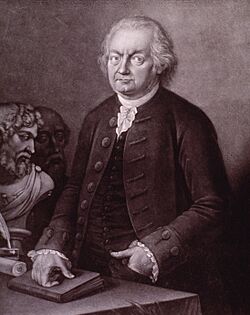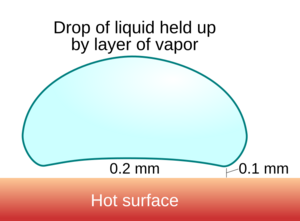Johann Gottlob Leidenfrost facts for kids
Johann Gottlob Leidenfrost was a smart German physician and theologian. He lived from 1715 to 1794. He is famous for being the first to describe a cool science trick called the Leidenfrost effect. This effect is even named after him!
Contents
Who Was Johann Gottlob Leidenfrost?
Johann Gottlob Leidenfrost was born in a place called Rosperwenda in Germany. His father, Johann Heinrich Leidenfrost, was a well-known minister. We don't know much about Johann's early life before he started his studies.
Early Life and Education
Johann first went to the University of Gießen. There, he started studying theology, just like his father. But soon, he became more interested in medicine. He then continued his medical studies at the University of Leipzig and the University of Halle.
In 1741, he earned his doctorate in medicine. This was for his excellent paper about how the human body moves. After finishing his studies, Leidenfrost traveled for a few years. He even worked as a doctor for soldiers during the first Silesian War.
A Career in Medicine and Science
In 1743, Leidenfrost became a professor at the University of Duisburg. Two years later, in 1745, he married Anna Cornelia Kalckhoff from Duisburg. They had seven children together. One of their daughters, Johanna Ulricke, later married a famous German theologian named Christian Krafft.
At the University of Duisburg, Leidenfrost taught medicine, physics, and chemistry. He also served as the university's rector, which is like being the head of the school. On top of all this, he had his own private medical practice.
In 1756, Leidenfrost became a member of the Berlin Academy of Sciences. During his lifetime, he wrote more than seventy books and papers! One of his most important works was "A Tract About Some Qualities of Common Water" (published in 1756). In this book, he first explained the amazing Leidenfrost effect. He passed away in Duisburg.
Understanding the Leidenfrost Effect
What is the Leidenfrost Effect?
The Leidenfrost effect is a cool science phenomenon. It happens when a liquid touches something much, much hotter than its boiling point. When this happens, the liquid doesn't boil right away. Instead, it creates a tiny layer of vapor (like steam) underneath itself. This vapor layer acts like a cushion or an insulator. It keeps the liquid from touching the super hot surface directly. This makes the liquid take longer to boil and evaporate.
Seeing the Effect in Action
You might have seen the Leidenfrost effect without even knowing it! It's often seen when you're cooking. Imagine you sprinkle drops of water into a very hot skillet to check its temperature. If the skillet is hot enough (at or above the Leidenfrost point), the water drops won't just sizzle and disappear quickly. Instead, they will skitter and dance across the metal surface. They will also take longer to evaporate than if the skillet was just hot, but not super hot.
People have also used this effect in some interesting demonstrations. For example, a wet finger dipped very quickly into molten lead, or blowing out a mouthful of liquid nitrogen, can be done without injury. This is because the Leidenfrost effect creates a protective vapor layer. However, these are very dangerous experiments and should NEVER be tried at home or without expert supervision!
Controlling the Effect
Scientists can even design special surfaces to control the Leidenfrost effect. They can make surfaces that prevent the vapor layer from forming. This allows liquids to cool very hot objects more efficiently, even at temperatures over 1150 °C. This technology can be used in things like thermal armor.



